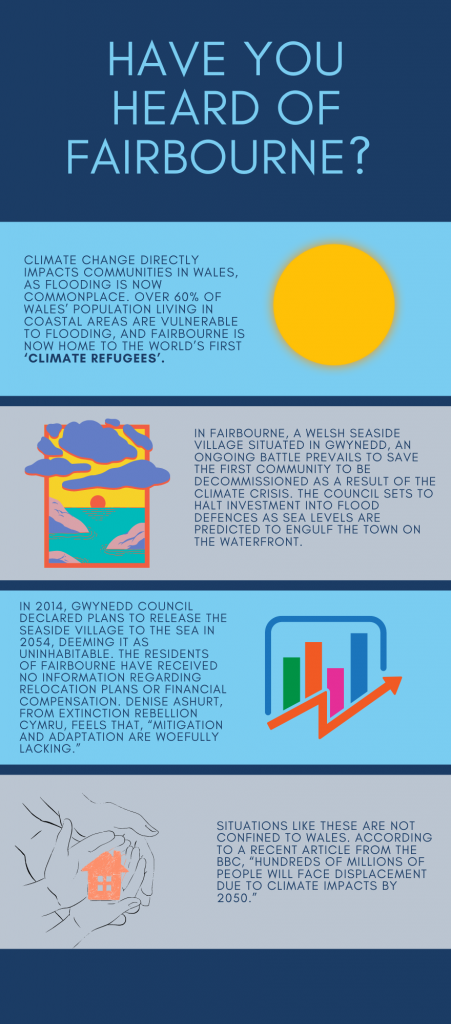Cardiff ranks as the 6th most at-risk city from coastal based flooding in the world, causing insurance companies to prepare for the worst

A few years ago Denise Ashurst, a member of Extinction Rebellion Cymru, decided to buy a house in Cardiff. While browsing housing websites, Denise noticed things that didn’t add up. “Some properties were very recently done up with brand-spanking-new kitchens and yet the price seemed suspiciously cheap,” she says.
Denise was aware that flooding in Wales has been a regular occurrence in recent years and considered the implications this would have on insuring the property she was looking to buy. She said, “I started looking at flood maps thinking, ‘If I’m going to buy a house, where am I going to be safe?’”
If I’m going to buy a house, where am I going to be safe?
Unbeknown to some homeowners residing in flood risk areas, while insurance premiums are relatively steady at this current time, there is a slow transition to risk-reflective pricing for household insurance.
Wales has seen its fair share of flooding in recent years, and in response the Welsh government, after having declared a climate emergency in 2019, plans to invest £238 million to deliver flood and coastal erosion commitments.
While most populated areas benefit from a national network of flood defence infrastructure, climate change is posing an increasing threat for those living on the coast. For the 245,000 Welsh properties at risk from flooding, the question remains as to how the climate crisis will influence the future of home insurance in high risk areas.
The climate crisis
According to the British Insurers Brokers Association, of the 28 million properties in the UK, 1 in 6 properties are at risk from flooding. In accordance with current housing development trends, up to 20,000 houses in the UK are set to be built on flood risk areas this year alone.
Rhys Griffith, senior communications officer at Natural Resources Wales, said that climate change is a vital consideration in much of their current work. The NRW has made valiant efforts to instigate flood defences and management systems through their Flood Risk Management projects.
Rhys said, “We are unable to continue defending against the risk presented by climate change. In vulnerable locations we will have to give serious consideration to adaptation or retreat.”
The Welsh government has now produced measures regarding adapting to climate change, saying that, “It is imperative that plans and investment projects consider the changing risks over the coming century.”The government has long been working alongside insurers to provide reinsurance coverage for properties in high risk areas, which seeks to keep householders premiums at a minimum. For the time being.

Watch this video explaining the article:
Insurance companies treading water
Referral to flood maps and assessing the risk before covering a property is now commonplace for insurers, who are increasingly vigilant of properties developed on flood plains.
Communications officer at the Nationwide head office in Swindon said when people go through mortgage applications they have checks with solicitors regarding flood maps, as properties built in high risk areas are given a different treatment. She said, “It is more of a regular procedure as the damage it can do financially is huge.”
Throughout the home buying process adequate measures are in place to ensure homeowners are well informed, and it would be reasonable to assume that insurance companies are well prepared for the risks imposed by sea level rise, yet it seems that this is unchartered territory. Upon contacting multiple insurers, Admiral was one of the only companies to offer a response.
James Carnduff, head of communications at Admiral, said they would, “Struggle to answer questions regarding the current and future state of home insurance in Wales.” Like many insurance companies contacted, enquiry was met with a referral to the Flood Re scheme.
Created in 2013, the Flood Re scheme is a joint initiative between the UK government and insurers, providing insurance coverage for domestic properties situated in high risk areas.
The aim of the initiative, which runs until 2039, is to ensure that homeowners see little rise in their insurance premiums regardless of location. However, upon its end date, Flood Re advises that, “Insurers offer policies based on actual risk to property.” Going on to state that some homes may be uninsurable in the coming years.

Staying afloat as a homeowner
Some homeowners may benefit from this scheme, as when buying home insurance the insurer may pass the flood risk element of the policy to Flood Re at a fixed price. In turn meaning if a claim is made for flooding, the insurance company will pay and later be reimbursed.
However, it is not applicable to homes built before 2009, indicative of the principle of avoiding development on areas of an unacceptable risk. Nick Green, a financial writer for Unbiased, a website which connects financial experts with clients, said that, “The greatest factor affecting premium price is where your home is located.”
The future of home insurance in high flood risk areas remains uncertain, but one thing which is certain, however, is that while the premiums in Wales have seen a steady increase of 1.3% each year, this trajectory is set to skyrocket.
When the Flood Re scheme dries up in 2039, flood insurance will be an unregulated free market.
It seems that retreating to the coast for peace of mind actually requires mindful consideration, as purchasing properties in vulnerable areas is becoming a risky business. Due to Denise Ashurst’s environmental expertise, she was able to find the ideal insurable property, but it wasn’t easy.
Top 5 high flood risk areas in Wales
- Cardiff
- Newport
- Gwent Levels
- Wider Gwent Area
- Pontypridd and Caerphilly
